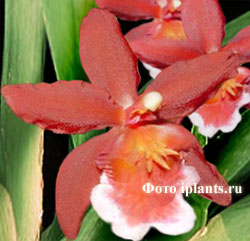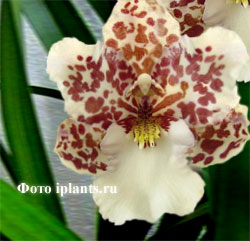
Orchid family. Homeland South and Central America. Vailstekeara belongs to the genus odontoglossum or intergeneric hybrids obtained by crossing genera: Miltonia x Cochlioida x Odontoglossum. This plant got its hard-to-pronounce name in honor of the parent - the Flemish gardener who created it in the 19th century. The purpose of hatching is to get a beautiful flower for cool rooms. They have flattened bulbs of an oval shape, bearing 2 leaves, broadly lanceolate in shape, up to 50 cm long, green. Peduncles are multi-flowered, appearing from the base of the bulb. The flowers are about 5-7 cm in diameter.
Hybrids Vuylstekeara "Violet Wood," Vuylstekeara "Edna Stamperland," Vuylstekeara "Fall In Love," Vuylstekeara "Helmut Sang" (pictured left), Vuylstekeara Linda Isler' Red '(pictured right)
On sale you can also find the Vuylstekeara Cambria hybrid Vuylstekeara Cambria - which is somewhat different in care, and is sold with the abbreviated name Cumbria.

Wilsteceara - Care and Cultivation
Temperature: This orchid, unlike most others, does not like too high temperatures, maximum in summer during the day 30 ° С, optimal about 25 ° С, at night it is necessary to drop to 16-18 ° С. In winter, you need to ensure a temperature in the range of 14-15 ° C. for good flowering, the orchid needs a period of rest, from about November to January, when there is clearly not enough light during the heating season. During the rest period, watering should be replaced by spraying.
It is also necessary to take care that the room is constantly ventilated. One of the mistakes in care is year-round maintenance in warm home conditions. Orchid flowering requires at least a month at 14-16 ° C to stimulate flowering. Peduncles are formed on young growths .
Lighting: Wilsteceara is light-loving but needs a good shade from direct sunlight in summer. The best place is the east or northwest windows, not shaded from the street by trees. Do not place this orchid near the south or west window, in summer, even under shade it will be too hot. But in winter, the south or south-west window is the most optimal place.
On other, cooler windowsills, the orchid can be illuminated. To do this, you can use LED lamps with a regular base (E27) - one lamp with a power of 6-7 W, or fluorescent lamps, also with a regular base with a power of 15-20 W. Such lamps can be screwed into a regular table lamp.
Watering: Abundant during growth in spring and summer - frequent moisturizing, but after drying the substrate during the day. In winter, watering is very moderate, i.e. moisten the substrate, just so that the bulbs do not wrinkle much. Watering water is soft, better boiled .
Fertilizer: In the period from the beginning of growth to ripening, the peduncle is fed with a special fertilizer for orchids in a dose two times less than for other orchids. When using fertilizers for other indoor plants, do not use nitrogenous fertilizers, you can only use fertilizers for flowering plants, while the dose is taken four times less than recommended in the instructions. Feeding is carried out every 2-3 weeks.
Air humidity: ideal humidity is from 60 to 75%, with good air ventilation. Avoid cold drafts, especially after watering.
Transplant: As needed in the spring. To protect yourself from losing your favorite orchid from decay, it is worth planting Vailstekeara in a mixture of pine bark, coarse fraction (up to 2 cm) and any inert material (pieces of foam, rings cut from a wine cork), and in order for the pot to stand stably, put one or two heavy stones on the bottom. At the bottom of the pot, there are simply large holes (not 1-2, but many), and it is good to make holes in the walls so that the air penetrates better to the roots. Of course, watering with such a landing by immersion, with the addition of fertilizers (special for orchids) to the water.
Reproduction: Division during transplantation. Part of the stem with aerial roots - at least three healthy roots - is separated from the mother plant. The cut must be sprinkled with crushed charcoal or sulfur. Plant in the bark, do not water for the first 3 days, only spray the leaves.